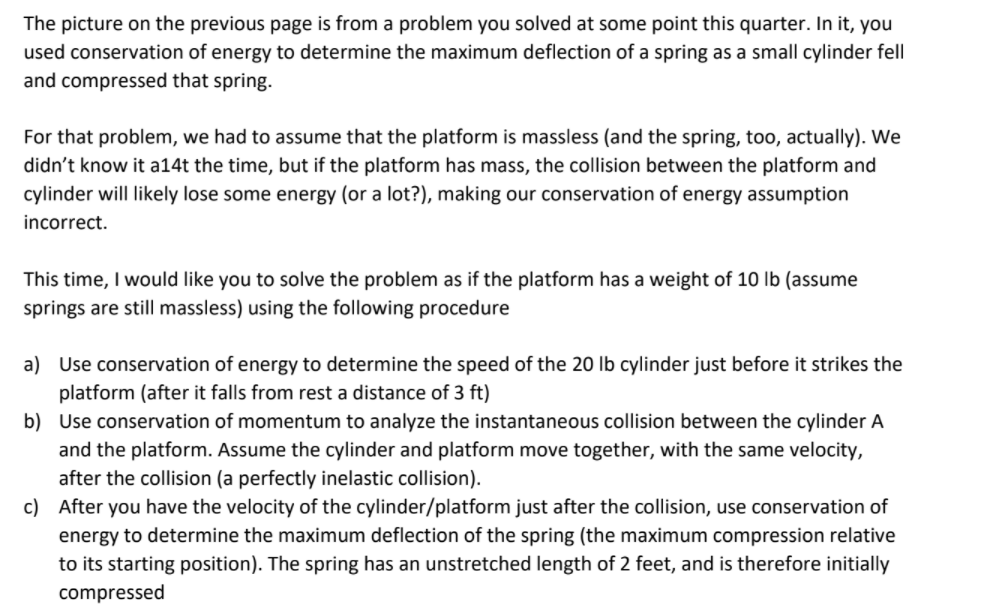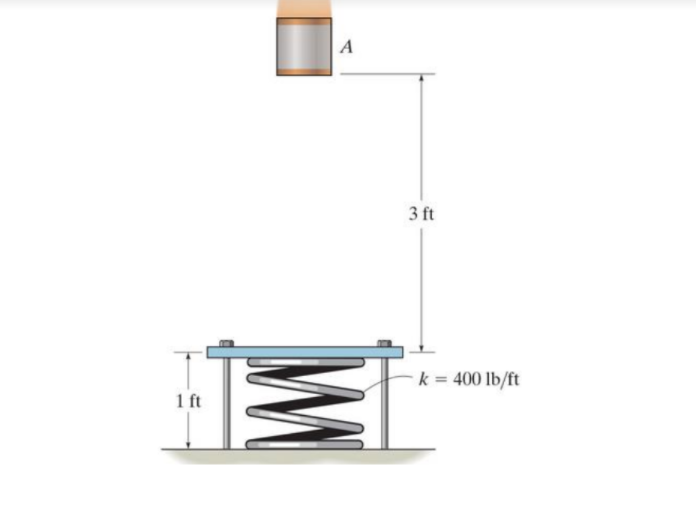This time, I would like you to solve the problem as if the platform has a weight of 10 Ib (assume springs are still massless) using the following procedure a) Use conservation of energy to determine the speed of the 20 Ib cylinder just before it strikes the platform (after it falls from rest a distance of 3 ft) b) Use conservation of momentum to analyze the instantaneous collision between the cylinder A and the platform. Assume the cylinder and platform move together, with the same velocity, after the collision (a perfectly inelastic collision). :) After you have the velocity of the cylinder/platform just after the collision, use conservation of energy to determine the maximum deflection of the spring (the maximum compression relative to its starting position). The spring has an unstretched length of 2 feet, and is therefore initially compressed
This time, I would like you to solve the problem as if the platform has a weight of 10 Ib (assume springs are still massless) using the following procedure a) Use conservation of energy to determine the speed of the 20 Ib cylinder just before it strikes the platform (after it falls from rest a distance of 3 ft) b) Use conservation of momentum to analyze the instantaneous collision between the cylinder A and the platform. Assume the cylinder and platform move together, with the same velocity, after the collision (a perfectly inelastic collision). :) After you have the velocity of the cylinder/platform just after the collision, use conservation of energy to determine the maximum deflection of the spring (the maximum compression relative to its starting position). The spring has an unstretched length of 2 feet, and is therefore initially compressed
Refrigeration and Air Conditioning Technology (MindTap Course List)
8th Edition
ISBN:9781305578296
Author:John Tomczyk, Eugene Silberstein, Bill Whitman, Bill Johnson
Publisher:John Tomczyk, Eugene Silberstein, Bill Whitman, Bill Johnson
Chapter1: Heat, Temperature, And Pressure
Section: Chapter Questions
Problem 17RQ: Convert 22C to Fahrenheit.
Related questions
Question

Transcribed Image Text:The picture on the previous page is from a problem you solved at some point this quarter. In it, you
used conservation of energy to determine the maximum deflection of a spring as a small cylinder fell
and compressed that spring.
For that problem, we had to assume that the platform is massless (and the spring, too, actually). We
didn't know it a14t the time, but if the platform has mass, the collision between the platform and
cylinder will likely lose some energy (or a lot?), making our conservation of energy assumption
incorrect.
This time, I would like you to solve the problem as if the platform has a weight of 10 lb (assume
springs are still massless) using the following procedure
a) Use conservation of energy to determine the speed of the 20 lb cylinder just before it strikes the
platform (after it falls from rest a distance of 3 ft)
b) Use conservation of momentum to analyze the instantaneous collision between the cylinder A
and the platform. Assume the cylinder and platform move together, with the same velocity,
after the collision (a perfectly inelastic collision).
c) After you have the velocity of the cylinder/platform just after the collision, use conservation of
energy to determine the maximum deflection of the spring (the maximum compression relative
to its starting position). The spring has an unstretched length of 2 feet, and is therefore initially
compressed

Transcribed Image Text:3 ft
k = 400 lb/ft
1 ft
Expert Solution
This question has been solved!
Explore an expertly crafted, step-by-step solution for a thorough understanding of key concepts.
Step by step
Solved in 2 steps with 2 images

Knowledge Booster
Learn more about
Need a deep-dive on the concept behind this application? Look no further. Learn more about this topic, mechanical-engineering and related others by exploring similar questions and additional content below.Recommended textbooks for you

Refrigeration and Air Conditioning Technology (Mi…
Mechanical Engineering
ISBN:
9781305578296
Author:
John Tomczyk, Eugene Silberstein, Bill Whitman, Bill Johnson
Publisher:
Cengage Learning

International Edition---engineering Mechanics: St…
Mechanical Engineering
ISBN:
9781305501607
Author:
Andrew Pytel And Jaan Kiusalaas
Publisher:
CENGAGE L

Refrigeration and Air Conditioning Technology (Mi…
Mechanical Engineering
ISBN:
9781305578296
Author:
John Tomczyk, Eugene Silberstein, Bill Whitman, Bill Johnson
Publisher:
Cengage Learning

International Edition---engineering Mechanics: St…
Mechanical Engineering
ISBN:
9781305501607
Author:
Andrew Pytel And Jaan Kiusalaas
Publisher:
CENGAGE L